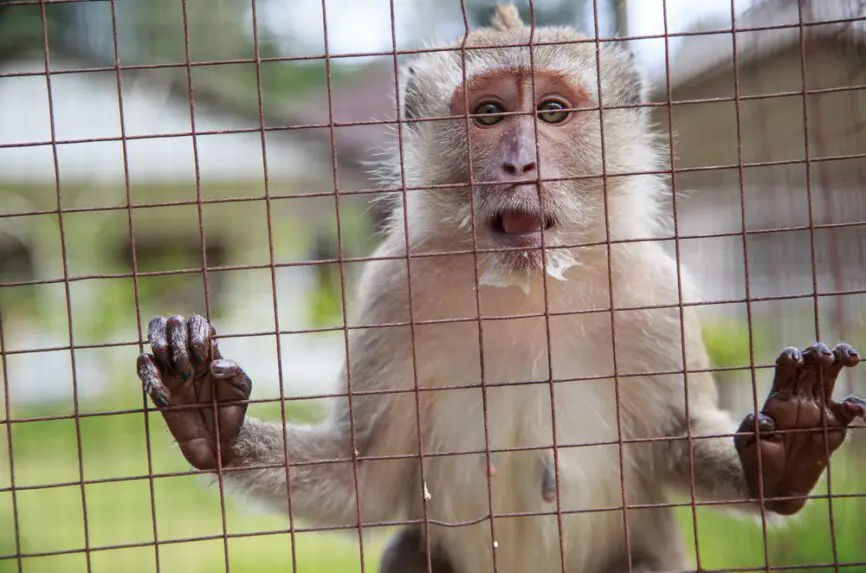Bioethics Forum Essay
Primates in Medical Research: A Matter of Convenience, not Sound Science
In Beaverton, Oregon, in one of seven National Primate Research Centers, a rhesus macaque sits in a cage awaiting her fate in an Alzheimer’s disease experiment. She is one of more than 100,000 monkeys–regarded by some neuroscientists as key to understanding dementia–forcibly separated from her family, traded as a commodity, and scheduled to die in a laboratory in the U.S. What are the current and future potential uses of nonhuman primates in research? The National Academies of Sciences, Engineering, and Medicine is examining this question.
Experiments on animals date back to at least 6 BCE when ancient Greek physicians, culturally forbidden from cutting open human bodies, turned to nonhuman bodies. By the 17th century, philosopher and scientist Francis Bacon asserted that the dissection of living animals could “sufficiently satisfy” as a substitute for human experiments. Although nonhuman primates have been dissected for ages, the systematic inclusion of nonhuman primates in research began in the last century.
After the Second World War, revelations of human research abuses led to the establishment of guidelines for the conduct of research with humans, such as the Nuremberg Code and the Declaration of Helsinki. By 1979, the National Commission for the Protection of Human Subjects of Biomedical and Behavioral Research, appointed by the U.S. Congress, published The Belmont Report, which laid ethical foundations for 20th century human research protections. The Belmont Report centered on the principle of justice and the importance of avoiding the selection of human research subjects based on convenience, accessibility, or manipulability.
While it was well-intentioned and rightly protected vulnerable populations, such as children and imprisoned persons, The Belmont Report encouraged a shift to research involving nonhuman primates and other animals. This shift has resulted in unresolved moral and scientific problems that can now only be addressed by another paradigm.
Today, unlike in the 17th century, scientists easily recognize the truth in the saying “mice lie and monkeys exaggerate,” which points to a well-known problem in biomedical research: using nonhuman primates and other animals in research fails more often than it succeeds. Approximately 90 percent of new investigational drugs–drugs that appear safe or effective in monkeys and other animals–fail to be safe and/or effective in humans. Nearly 100 percent of the drugs developed for Alzheimer’s in decades of research have failed. As researchers at the Oregon National Primate Research Center in Beaverton wrote in 2021, “in the rhesus macaque model of aging, all four major hallmarks of [Alzheimer’s disease]—significant cognitive decline, amyloid beta plaques, p-tau tangles, and neuronal death—do not reach the pathological levels of clinical [Alzheimer’s disease].” In other words, these monkeys do not develop Alzheimer’s disease.
If researchers were to extend The Belmont Report’s principle of justice to nonhuman primates and other animals, they would perhaps acknowledge that the continued use of these animals is a matter of convenience, accessibility, and their vulnerability to coercion rather than a matter of sound science. The translational failures of science discount lives that are utterly thrown away in experiments that we have good reason to expect will fail. Animals are treated like disposable equipment rather than as conscious, living, feeling beings.
Translational failures also harm humans—those who will face the risks of human experiments based on animal research and those who will continue to wait for medical treatments that are promised but not delivered. The translational failures of biomedical research are not just a scientific problem, but a moral problem—a failure to recognize the value of both nonhuman and human lives.
Failures to transform medical research are propelled by institutional biases and by limitations in transparency and in accountability for spending trends—all of which are complicated by long-standing relationships between the pharmaceutical industry, academia, and government. This network of influence has contributed to a shift away from health research and planning that was historically focused on the public interest to research priorities that are now largely driven by profit margins. Many stakeholders within the industry-academia-government complex have an interest in animal research remaining the norm. The National Primate Research Centers are a notable example.
Nonetheless, public pressure does from time-to-time break through and cause policy makers to reevaluate the norm. For example, in 2011, following a request from the U.S. Congress and the National Institutes of Health, an Institute of Medicine Committee on the Use of Chimpanzees in Biomedical and Behavioral Research concluded that most current uses of chimpanzees in research were unnecessary. Chimpanzees are humans’ closest living relatives, yet chimpanzee experiments are still viewed as unreliable and unnecessary. A growing number of physicians and scientists realize that evolutionary and individual differences within and across species impede the translation of animal research findings to humans—even for animals who are so like us.
This year, in response to a request from Congress and the NIH, the National Academies of Sciences, Engineering, and Medicine (comprising the former IOM) is again examining the use of nonhuman primates in research. But rather than asking if monkeys should be used in research, the NIH’s mandate to the NASEM committee leaves that important question off the table. To protect the status quo, the committee is comprised of individuals entrenched in primate research, and the only members to disclose conflicts of interest are those with an interest in nonanimal methods.
But the status quo isn’t working, as decades of science demonstrate. Across the US, the families of the estimated six million people living with Alzheimer’s disease—and the physicians treating them—are desperate for answers. They know the suffering Alzheimer’s can cause, and they want more effective prevention and treatment strategies.
As Thomas Insel, the former National Institute of Mental Health director, explained in his book Healing, we need to shift from relying on reductionist models of disease to looking at what patients, families, and communities living with various forms of psychiatric and neurological illness experience and need. This shift, overturning the status quo, requires investing in ethically designed studies that center on patients and population-based interventions, as well as on science that is centered on human biology and systems. Such a shift requires recognizing the failure of 17th century ideas, and reimagining and modernizing biomedical research to meet the real needs of patients and the demands of justice.
Hope Ferdowsian, MD, MPH, is an associate clinical professor at the University of New Mexico School of Medicine, and president and CEO of Phoenix Zones Initiative. @HopeFerdowsian
L. Syd M. Johnson, PhD, is an associate professor at the Center for Bioethics and Humanities and a clinical ethics consultant at Upstate Medical University in Syracuse, N.Y. @LSydMJohnson














Thanks, team for this reawakening call to end this vice, more resources need to be channeled to research on IT modeling as a replacement for the use of primates in biomedical research.
#Animal lives matter
#Animals too deserve another chance to live